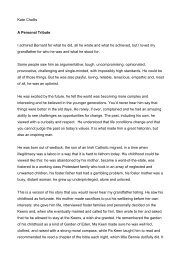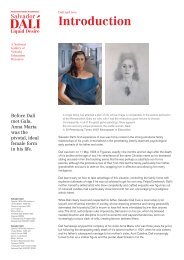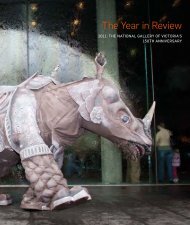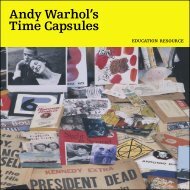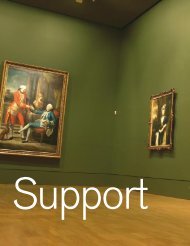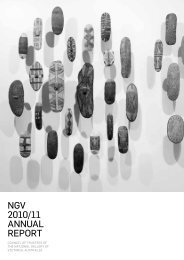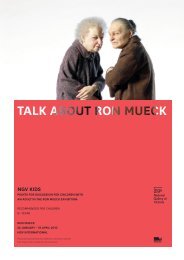Giambattista tiepolo The banquet of Cleopatra 1743–44 - National ...
Giambattista tiepolo The banquet of Cleopatra 1743–44 - National ...
Giambattista tiepolo The banquet of Cleopatra 1743–44 - National ...
Create successful ePaper yourself
Turn your PDF publications into a flip-book with our unique Google optimized e-Paper software.
<strong>Giambattista</strong> <strong>tiepolo</strong><br />
Italian 1696–1770<br />
<strong>The</strong> <strong>banquet</strong> <strong>of</strong> <strong>Cleopatra</strong> <strong>1743–44</strong><br />
oil on canvas<br />
250.3 x 357.0 cm<br />
<strong>National</strong> Gallery <strong>of</strong> Victoria, Melbourne<br />
Felton Bequest, 1933 (103-4)<br />
<strong>The</strong> story <strong>of</strong> Mark Antony (83–30 BC) and <strong>Cleopatra</strong> (69–30<br />
BC) was a popular subject for artists in the eighteenth century.<br />
<strong>The</strong> ancient tale <strong>of</strong> the Roman consul and his relationship with<br />
the Egyptian queen provided them with stories <strong>of</strong> romance, war,<br />
military splendour, tragedy and death. <strong>The</strong> love affair between<br />
Mark Antony and <strong>Cleopatra</strong> also enabled artists to depict the<br />
classic opposites <strong>of</strong> male and female, East and West.<br />
<strong>The</strong> episode represented in Tiepolo’s <strong>The</strong> <strong>banquet</strong> <strong>of</strong> <strong>Cleopatra</strong><br />
is drawn from the Roman historian Pliny’s Natural History (written in<br />
AD 77). Here Pliny recounted the tale <strong>of</strong> a famous contest between<br />
the Egyptian and Roman rulers (who became lovers), whereby<br />
<strong>Cleopatra</strong> wagered that she could stage a feast more lavish than the<br />
legendary excesses <strong>of</strong> Mark Antony. Tiepolo’s painting shows the<br />
dramatic moment at the end <strong>of</strong> <strong>Cleopatra</strong>’s sumptuous repast when,<br />
faced with a still scornful Mark Antony, she wins the wager with her<br />
trump card. Removing one <strong>of</strong> a pair <strong>of</strong> priceless pearls that adorn her<br />
as earrings, <strong>Cleopatra</strong> dissolves the pearl in a glass <strong>of</strong> vinegar and<br />
drinks it, an extravagance that causes Mark Antony to lose his bet.<br />
<strong>The</strong> <strong>banquet</strong> <strong>of</strong> <strong>Cleopatra</strong> was purchased directly from Tiepolo’s<br />
Venice studio in early 1744 by Count Francesco Algarotti for Augustus<br />
III, Elector <strong>of</strong> Saxony and King <strong>of</strong> Poland. A member <strong>of</strong> the Court <strong>of</strong><br />
Saxony, Algarotti had presented the king in 1742 with a proposal<br />
to update the Royal Museum at Dresden through the acquisition <strong>of</strong><br />
a small selection <strong>of</strong> modern paintings that would balance the old<br />
masters already in the king’s collection. <strong>Giambattista</strong> Tiepolo, at the<br />
time one <strong>of</strong> the most celebrated contemporary artists working in<br />
Europe, was an obvious choice for Algarotti. Surviving documents<br />
tell us that on 10 February 1744 Count Algarotti paid for a frame<br />
for <strong>The</strong> <strong>banquet</strong> <strong>of</strong> <strong>Cleopatra</strong>. On 5 March 1744 the artist was paid<br />
300 zecchini (Venetian gold coin) for the painting, which was then<br />
dispatched to Dresden (and, subsequently, to the Royal Hunting<br />
Lodge at Hubertusburg), remaining in the royal collections <strong>of</strong> Saxony<br />
until 1765. By the turn <strong>of</strong> the nineteenth century, <strong>The</strong> <strong>banquet</strong> <strong>of</strong><br />
<strong>Cleopatra</strong> had entered the Russian imperial collections, and was<br />
for a time placed on a ceiling within the Mikhailovsky Castle in St<br />
Petersburg. Later it was transferred to the Hermitage Palace, where<br />
it remained until sold to Melbourne by the Soviet authorities in 1932.<br />
Ted Gott<br />
<strong>Giambattista</strong> <strong>tiepolo</strong><br />
Italiano 1696–1770<br />
El <strong>banquet</strong>e de <strong>Cleopatra</strong>, (<strong>1743–44</strong>)<br />
óleo sobre lienzo<br />
250,30 x 357,00 cms<br />
Galería Nacional de Victoria, Melbourne<br />
Legado Felton, 1933 (103-4)<br />
La historia de Marco Antonio (83-30 a.C.) y <strong>Cleopatra</strong> (69-30<br />
a.C.) fue un tema popular entre los artistas de siglo XVIII. La<br />
historia de la relación entre el cónsul romano y la reina egipcia<br />
les proporcionó romance, guerra, esplendor militar, tragedia y<br />
muerte. La aventura amorosa entre Marco Antonio y <strong>Cleopatra</strong><br />
permitió a los artistas reflejar en sus obras el clásico contraste<br />
entre lo masculino y lo femenino, oriente y occidente.<br />
El episodio representado en El <strong>banquet</strong>e de <strong>Cleopatra</strong> de Tiepolo<br />
se inspira en La historia natural del historiador romano Plinio (escrita<br />
en el 77 d.C.). Plinio narra la famosa competición entre la reina<br />
egipcia y el cónsul romano (que luego serían amantes). <strong>Cleopatra</strong><br />
había apostado que podía <strong>of</strong>recer un <strong>banquet</strong>e más lujoso que los<br />
legendarios y excesivos de Marco Antonio. El cuadro de Tiepolo<br />
muestra el momento dramático, al final de la suntuosa comida,<br />
en el que <strong>Cleopatra</strong>, frente al todavía desafiante Marco Antonio,<br />
gana la apuesta al quitarse uno de sus valiosísimos pendientes<br />
de perlas, disolver la perla en un vaso de vinagre y bebérselo,<br />
extravagancia que hace que Marco Antonio pierda la apuesta.<br />
A principios de 1744 El <strong>banquet</strong>e de <strong>Cleopatra</strong> fue comprado<br />
directamente al estudio de Tiepolo en Venecia por el conde Franchesco<br />
Algarotti para el rey de Polonia y elector de Sajonia Augusto III.<br />
Algarotti había propuesto al rey en 1742 un plan para modernizar<br />
el Museo Real de Dresde mediante la adquisición de una pequeña<br />
selección de pinturas modernas y así crear un cierto equilibrio con las<br />
antiguas obras maestras de arte ya existentes en la colección real.<br />
Para Algarotti, el adquirir una obra de <strong>Giambattista</strong> Tiepolo, uno de los<br />
artistas contemporáneos más famosos en Europa, era una decisión<br />
obvia. Sabemos, gracias a los documentos que hoy perduran, que el<br />
10 de febrero de 1744 el Conde Algarotti pagó el coste del marco;<br />
y que el 5 de marzo de 1744 le pagaron al artista 300 zecchini .<br />
El cuadro fue enviado a Dresde (y, posteriormente, al palacete de<br />
caza de Hubertusburg) y permaneció en la colección real de Sajonia<br />
hasta 1765. A finales del siglo XIX El <strong>banquet</strong>e de <strong>Cleopatra</strong> pasó<br />
a la colección imperial rusa y durante un tiempo estuvo colgado del<br />
techo del Castillo de Mikhailovsky en San Petesburgo. Más tarde,<br />
fue trasladado al Palacio Hermitage donde permaneció hasta que<br />
fue vendido a Melbourne por las autoridades soviéticas en 1932.



